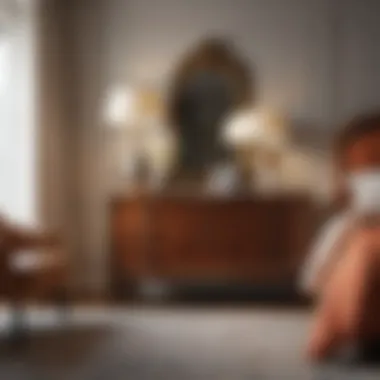Exploring the Allure of 1960s Bedroom Furniture


Intro
The decade of the 1960s marked a pivotal shift in styles and tastes, particularly within the realm of home decor. In this period, bedroom furniture transcended mere functionality; it became a canvas for personal expression and a reflection of societal changes. The allure of 1960s bedroom furniture lies not just in its unique aesthetic, but also in the meaningful narratives it conveys—a time when color, form, and innovation danced harmoniously to a rhythm all their own.
As families sought to create warm, inviting spaces, the designs of the time catered to a sense of tranquility mixed with an unapologetic vibrancy. With the advent of modernism and the gradual acceptance of varied styles, the 1960s introduced a flurry of options for both bedroom aesthetics and functionality. This article aims to explore these distinctive features, highlighting key trends that continue to inspire contemporary layouts while also addressing sourcing tips and care practices.
No matter if you are a seasoned enthusiast or just dipping your toes into the world of vintage furniture, understanding the charm and appeal of 1960s pieces will open doors to creating your own serene sanctuary.
In the following sections, we will delve into current trends in color palettes and styles, providing readers not just with insights but practical guidance on how to incorporate these vintage treasures into modern living. Through a careful examination of visuals and transformative ideas, we will showcase the true essence of 1960s bedroom furniture and its timeless relevance.
The Significance of 1960s Bedroom Furniture
The 1960s marked a turning point in furniture design, especially in the realm of bedroom furnishings. This decade didn't just see a shift in aesthetics; it also reflected broader cultural transformations that were taking place across the globe. For enthusiasts and homeowners alike, understanding the significance of this era's bedroom furniture goes beyond recognizing its style; it involves appreciating its role in shaping social norms, individual tastes, and interior design principles that still resonate today.
Cultural Context of the Sixties
The Sixties was a time of upheaval and creativity. Amid movements like civil rights and the counterculture, people sought ways to express their identity in every facet of their lives – including their living spaces. The bedroom became a personal sanctuary, a place where individuals could reflect their values and aspirations. Unlike the more formal and rigid styles of the 1950s, the furniture from this decade embraced freedom and flexibility. Bright colors, funky patterns, and innovative shapes were all the rage, making bedrooms a canvas for self-expression.
"In this era, furniture became more than just items; they transformed into statements of individuality."
Influential Designers of the Era
There were several key figures who played pivotal roles in shaping the aesthetic of bedroom furniture during the 1960s. Designers like Charles and Ray Eames pushed the boundaries of form and functionality, infusing their work with an artistic flair that made everyday items captivating. Alongside them, names like George Nelson and Isamu Noguchi introduced designs that combined minimalism with artistic elements, leading to bold pieces that challenged traditional views on what furniture should be. Their works didn’t just cater to practicality but also invited a deeper emotional connection, inviting individuals to engage with their living environment more thoughtfully.
The Evolution of Bedroom Design
Before the 1960s, bedroom designs often leaned heavily into traditional styles, emphasizing symmetry and classic forms. With the arrival of this vibrant decade, there was a clear shift toward a more organic approach. Bedroom design evolved to include open layouts, multifunctional furniture, and a blend of styles that reflected a youthful exuberance. Upholstered headboards, open shelving, and more playful forms allowed people to arrange their space in ways that defied conventionality. The bedroom transformed dramatically, moving away from a simple sleeping space to a hub of creativity and comfort.
The furniture from this decade serves as a testament to an era that valued both style and personal expression. In a world that continues to evolve, 1960s bedroom furniture remains significant as it encapsulates a spirit of innovation and self-discovery that is often sought after in today's designs. The nostalgic charm linked with those pieces continues to influence contemporary interior design, proving that while styles may change, the essence of expressing individuality through home decor remains timeless.
Key Features of 1960s Bedroom Furniture
The allure of 1960s bedroom furniture doesn’t just lie in its aesthetic charm; it is embedded in the unique elements that define its character. These features encapsulate a pivotal moment in design history where functionality gracefully merged with stylish expressions of individuality. Delving into the specifics helps us appreciate the meticulous craftsmanship, distinctive color palettes, and innovative functional design elements that set this era apart.
Materials and Craftsmanship
The materials used in 1960s bedroom furniture tell a vibrant story of innovation and creativity. Unlike previous decades where heavy woods dominated, the sixties saw an embrace of lighter materials such as plywood, teak, and even molded plastics. This shift was not just about aesthetics; it also aimed to create furniture that was both lighter in weight and suitable for modern living.
Furniture designers like George Nelson and Charles Eames redefined what materials could accomplish. Their use of birch and bent plywood not only enhanced the visual appeal but also improved the durability of the furniture. It was a time of experimentation - combining silk-screened graphics with furniture forms, which resulted in eye-catching pieces that still feel fresh today.
To grasp the craftsmanship of this era, one must note the attention to detail given to each creation. Hand-joinery and quality finishes were standard, with many pieces likened to functional art.
Color Palettes and Patterns
A notable feature of 1960s bedroom furniture is its bold use of color and patterns. The sixties were a riot of hues, marking a departure from the muted tones of previous decades.
Deep mustard yellows, saturated teals, and fiery oranges became central in production, often accented by playful polka dots and geometric designs.
When we talk about patterns, we can’t overlook the influence of the Pop Art movement. Cushions, wallpapers, and textiles often featured graphic prints that reflected the dynamic spirit of the time. The concept was simple: to inject energy and personality into the living spaces, making bedrooms feel unique and lived-in rather than sterile.
By incorporating color and patterns, these pieces not only accentuated the aesthetic but also influenced how spaces were experienced. A pop of vibrant color has the potential to transform a room from bland to beautiful.
Functional Design Elements


Functionality was at the heart of 1960s bedroom furniture design. This era was characterized by a focus on multi-purpose items, catering to the fast-paced lifestyle that began to take root in society.
For instance, many beds featured built-in storage options, addressing a common concern of limited space in burgeoning urban centers. Designers like Hans Wegner introduced pieces that were not only elegant but served multiple functions—a perfect example being the use of nightstands with drawers to maximize utility.
Another interesting facet was the advent of modular furniture. The idea was to create systems that could be adapted to different needs, making furniture not just a fixture but a cornerstone for creating adaptable living environments.
"In the 1960s, furniture wasn't just about looks; it was about creating a lifestyle that resonated with the needs of a changing society."
These key features of 1960s bedroom furniture contribute to its enduring charm and relevance in modern design. They showcase a unique blend of innovation and artistry that allows these vintage pieces to fit seamlessly into contemporary spaces while still preserving their iconic character.
Styles of 1960s Bedroom Furniture
The styles of 1960s bedroom furniture depict a fascinating shift in design philosophy that reflects the socio-cultural dynamics of the decade. This era surged ahead with bold ideas, breaking away from past constraints and venturing into more expressive realms. Understanding these styles provides insight not only into the trends of the time but also into their lasting impact on contemporary design. Embracing the variety in styles allows homeowners today to create unique spaces that exude character and history.
Mid-Century Modern Influence
Mid-century modern design serves as a hallmark of 1960s home décor, leaving an indelible mark on furniture styles. This movement is characterized by clean lines, organic forms, and a focus on function without unnecessary embellishments. Designers such as Charles and Ray Eames harnessed innovative materials like molded plywood and fiberglass, which revolutionized comfort and aesthetics.
One of the key benefits of incorporating mid-century modern elements into a bedroom is their adaptability; they can coexist with many styles, ensuring a flexible and inviting space.
- Sleek Lines: Elegant, functional design that you can easily mix with contemporary setups.
- Natural Materials: Wood grains and soft textiles lend warmth, creating a cozy atmosphere.
- Iconic Pieces: Think of the Eames lounge chair or the platform bed, both timeless treasures that enhance any living space.
This style emphasizes an aesthetic that resonates deeply with today’s quest for simplicity and efficiency, with a nod to nostalgia.
Pop Art and Eclectic Trends
The vibrant pop art movement influenced furniture design, encouraging a playful interaction with colors and patterns. Bright, bold colors found their way onto walls and furniture, as designers experimented with combinations that were once seen as too audacious.
Incorporating pop art-inspired pieces offers several benefits:
- Expressive Spaces: These designs allow for individual expression, breaking the mold of monotony.
- Playful Patterns: From polka dots to stripes, patterns inject life into a room, turning it into a canvas of artwork.
- Neat Accents: Sometimes, a single pop art piece can transform an entire room, making it feel both unique and lively.
The eclectic trends of the time encouraged mixing and matching, promoting a culture of creativity and experimentation in interior design. This encourages homeowners today to think outside the box when styling their spaces.
Scandinavian Minimalism
On the flip side, Scandinavian minimalism surged in popularity, offering a calm and serene alternative to the flamboyance of pop art. This style prioritizes functionality, simplicity, and natural elements that appeal to all senses. The focus is on creating spaces that promote relaxation and tranquility, essential for a bedroom.
Key features include:
- Light Color Palette: Whites, soft grays, and muted pastels create a peaceful environment conducive to rest.
- Natural Light: Large windows and open spaces enhance the connection with nature, vital for mental well-being.
- Functional Design: Every piece serves a purpose, often boasting clean lines and minimal ornamentation, making it easier to maintain a tidy atmosphere.
Scandinavian minimalism teaches the invaluable lesson of less is more; it encourages viewers not to overwhelm a space with excessive furniture or décor, fostering serenity and calm.
"Design is not just what it looks like and feels like. Design is how it works." – Steve Jobs
In summary, the styles of 1960s bedroom furniture reflect a remarkable range of influences, from the understated elegance of mid-century modern pieces to the exuberant twists of pop art and the soothing simplicity of Scandinavian minimalism. Each style embodies its own benefits and appeals to different sensibilities, making them ever-relevant for today’s homeowners. Understanding these styles not only adds depth to your design choices but also pays homage to the rich history of 1960s furniture.
Where to Find 1960s Bedroom Furniture for Sale
Finding authentic 1960s bedroom furniture can feel like searching for a needle in a haystack, but with the right knowledge and resources, it becomes a victorious hunt. This section is all about helping you locate those special pieces that can effortlessly elevate your living space. Understanding where to buy not only adds that vintage charm to your home but also gives you a taste of history. The hunt for mid-century furnishings brings its own rewards, from the joy of discovering unique finds to the stories these pieces tell.
Vintage Stores and Flea Markets
Venturing into vintage stores and flea markets is like diving into a treasure chest—often chaotic, sometimes overwhelming, but with a promise of delightful surprises. These venues offer a curated yet eclectic array of furniture, art, and décor from the 1960s that simply can’t be found anywhere else.


- Authenticity: Many vintage stores have experienced staff who are knowledgeable about the history and craftsmanship of the pieces they sell. This can be invaluable in ensuring that what you purchase is legitimate and well-preserved.
- Bargaining Opportunities: At flea markets, there's often room to negotiate the price. A friendly chat with the seller can lead to better deals and possibly uncover the story behind the item.
- Chance to Explore: These markets not only offer items but also an experience. The thrill of browsing through various booths, chatting with vendors, and maybe even turning up an unexpected gem is part of the charm.
Online Marketplaces
If you're sitting at home and can’t make it to a local market, online marketplaces like eBay, Etsy, and Facebook Marketplace provide an alternative that opens up a world of options. Here’s how they make finding 1960s bedroom furniture that much easier:
- Wide Selection: You can filter your search based on specific styles or designs, providing a more tailored shopping experience.
- User Reviews: Reading seller reviews can help provide an idea of trustworthiness and item quality, ensuring you spend your money wisely.
- Convenience: Need something without the fuss? You can browse from your couch, and some sellers even arrange shipping, making it easier than ever to incorporate these vintage pieces into your home.
Auctions and Estate Sales
Participating in auctions and estate sales can be exhilarating and often rewarding. Not only do you get the chance to bid on beautiful pieces, but you might just find rare items at a fraction of the cost. Here are some considerations:
- Living History: Many estate sales involve families looking to part with loved pieces. Learning about the history of an item can add an emotional layer to your purchase, making it more than just furniture.
- Competitive Bidding: The thrill of bidding against others means you can sometimes acquire a piece that you might not find in a store or online.
- Loss Aversion: Auctions can promote a sense of urgency. In those bidding moments, you might be moved by the desire to rescue a piece from being lost forever.
"Whether in a cozy vintage shop, an expansive online marketplace, or a nail-biting auction, the pursuit of iconic 1960s furniture is not just about finding a couch or a bed—it's about connecting with a vibrant past and bringing it into your present."
Ultimately, the hunt is part of the joy. Whether trawling through dusty flea markets or bidding fervently at auctions, the process of securing 1960s bedroom furniture is an adventure filled with limitless potential.
Incorporating 1960s Bedroom Furniture into Modern Spaces
In the labyrinth of modern design, integrating pieces from the 1960s not only brings a unique character but also fosters a dialogue between eras. The mid-century modern aesthetic is celebrated for its timelessness, and incorporating 1960s bedroom furniture can transform a contemporary space into one that tells a story. The dialogue becomes particularly potent when considering how vintage flair can work in harmony with modern simplicity, making your home both nostalgic and relevant.
Blending with Contemporary Design
Blending 1960s furniture with contemporary design is akin to mixing old wine with a new label; the essence remains rich. Notable pieces such as a sleek teak dresser or a low-profile platform bed can introduce warmth to an otherwise sterile environment. The secret here lies in balance—pairing a bold, patterned swivel chair with a muted color palette helps each piece to shine without overwhelming the senses.
Consider the following tips:
- Harmonize Color Schemes: Utilize colors prevalent in modern styles, such as white, gray, and earthy tones, while letting the vivid hues of the sixties stand out.
- Mix Materials Wisely: Merging wood from the 1960s with modern materials like glass or metal can create an intriguing contrast.
- Focus on Functionality: Choose furniture that serves a purpose while also being an aesthetic statement.
Creating a Themed Room
Embarking on the journey to create a themed room using 1960s bedroom furniture can be thrilling. This theme not only captures nostalgia but also invites creativity. Think about a “retro chic” look, where everything from bedding to artwork reflects this vibrant era. Key elements to consider include:
- Retro Patterns: Implement throw pillows and bedding adorned with geometric or psychedelic patterns that echo the decade’s design ethos.
- Accessorizing with Style: Vintage lamps, choice of wall art, and decorative accents can amplify the 1960s vibe.
- Coordinating Furniture Pieces: Look for a cohesive color scheme that celebrates the iconic hues of the sixties like mustard yellow or avocado green.
"A thematic approach invites not just visual interest but also sparks conversations that can breathe life into any gathering."
Accent Pieces vs. Full Set Integrations
When it comes to incorporating 1960s furniture into a modern setting, one has to weigh the pros and cons of using full sets versus mixing in accent pieces.
- Accent Pieces: These are like spices; they should complement but not overpower. A single item, such as a vintage nightstand or a funky chair, can act as a focal point while maintaining the overall harmony of the space. Accent options are less commitment—easier to replace or swap out should the need arise.
- Full Set Integrations: Opting for a complete bedroom set can offer a seamless and cohesive look. However, this route requires careful thought to ensure the design of the furniture aligns with the overall aesthetic of your space.
In summary, whether opting for accent pieces or full sets, the aim is to create a harmonious blend that resonates with your personal style while honoring the history that these 1960s treasures bring to your modern spaces. Understanding the nuances of each approach can elevate your home’s design narrative, allowing it to be both inviting and reflective of your unique taste.
Caring for and Maintaining 1960s Bedroom Furniture
Caring for and maintaining 1960s bedroom furniture is crucial for preserving its unique charm and functionality. This vintage furniture, steeped in history, requires a bit more attention than modern pieces, and knowing how to care for it can go a long way in extending its life. A well-maintained piece not only serves its purpose but also becomes a talking point and an essential part of your home’s aesthetic.
Proper Cleaning Techniques
Keeping 1960s bedroom furniture clean is not just about aesthetics; it's about preventing damage from dust, dirt, and grime.
- Use Gentle Materials: Choose soft, lint-free cloths made of cotton or microfiber for dusting. Avoid using rough materials that can scratch the surface.
- Mild Cleaners: Always opt for gentle, pH-balanced cleaners when tackling tougher spots. For wood finishes, a simple mix of warm water and vinegar can work wonders without harming the finish.
- Avoid Excess Moisture: When cleaning, avoid soaking the furniture. Too much water can damage wood and cause it to warp. Wipe surfaces with a damp cloth followed immediately by a dry one to prevent moisture from settling.


Keeping surfaces free from clutter also helps in minimizing dust accumulation—It makes the cleaning faster and the space more pleasant.
Restoration and Repair Tips
Over time, even the best-kept furniture may need some repair. When addressing restoration, it's essential to be careful and consider the original materials.
- Identifying Damage: Before doing any repairs, understand the kind of damage. Small scratches can often be masked with wood polish or filler, while larger issues may require sanding.
- Re-gluing Joints: If you notice any loose joints, it's wise to re-glue them. Use a quality wood glue, applying it and clamping the pieces until set.
- Finishing Touches: For a complete restore, consider re-staining or waxing to bring back luster. Select a product that matches the original finish to maintain authenticity.
Engaging with the restoration process can provide a deeper appreciation of the craftsmanship and history behind each piece.
Storage Considerations
Proper storage is key to maintaining the integrity of your 1960s furniture. If you're planning on storing any pieces, take precautions to protect them from potential damage.
- Environment Control: Always store furniture in a climate-controlled environment. Avoid basements or attics, where moisture can warp wood or create mold.
- Cover Up: If using furniture covers, make sure they're breathable to prevent moisture buildup while protecting against dust.
- Avoid Stacking: Stack item on top of one another can cause scratches or dents. Instead, store them standing, keeping space between each piece to allow air circulation.
Taking these steps can immensely improve the longevity of your vintage treasures, allowing you to enjoy them for years to come.
"Proper care can turn a vintage piece not just into a functional item but a cherished family heirloom."
By understanding the importance of specific maintenance practices, you can safeguard your furniture, ensuring that the essence of the 1960s continues to enhance your living space.
The Future of Vintage Furniture in Interior Design
Vintage furniture, particularly from the distinctive 1960s era, stands as a hallmark of style and craftsmanship. Its relevance is witnessing a resurgence, largely due to a growing appreciation for unique design, historical significance, and sustainability. As we look ahead, incorporating vintage pieces not only enriches modern decor but also fosters a sense of character in homes. Understanding the trajectory of this trend can substantially inform how we curate our living spaces.
Timeless Appeal of Vintage Pieces
The charm of 1960s furniture lies in its ability to transcend time. These pieces resonate with a certain swagger that today's mass-produced furniture often lacks. The curves, colors, and quality of these items serve as a bridge to the past, creating nostalgic connections for many. When you step into a room adorned with a mid-century chest of drawers or a Scandinavian-style nightstand, there's an intrinsic warmth that modern alternatives rarely replicate.
- Aesthetic Diversity
- Conversation Starters
- Vintage pieces offer a variety of styles that can complement different themes.
- The craftsmanship of the 60s is marked by creativity, showcasing bold patterns and inviting colors.
- Each piece often carries a story - whether it’s from a family heirloom or a flea market find, they serve as focal points in any room.
Thus, embracing these vintage items is not merely a nod to the past but a deliberate choice to express individuality in decor.
Sustainability and Ethical Considerations
Sustainability in furniture design is becoming increasingly significant as the world wrestles with environmental challenges. Vintage furniture presents an excellent solution. Rather than opting for new pieces that contribute to pollution and waste, individuals can choose to invest in vintage items. This choice reduces the strain on our planet, encouraging recycling and repurposing practices that align with ecological ethics.
- Using vintage furniture helps diminish carbon footprints associated with manufacturing.
- Furthermore, the durability of 1960s pieces often outweighs today’s rushed production methods, leading to longer-lasting items that don’t need frequent replacements.
Admiring the craftsmanship, one cannot ignore how vintage furniture quietly champions eco-friendly practices.
The Resurgence of Retro Trends
The nostalgia for past styles is more than just a fleeting fancy; it’s a full-blown movement echoing through modern decor. With more homeowners rediscovering the magic of the 1960s, it’s clear that retro trends are stepping into the limelight once again.
- Fashion Influence
- Social Media Impact
- There’s been a revival not just in interiors but also in fashion, cinema, and art scenes. Designers are taking cues from vintage styles and translating them into contemporary aesthetics.
- Platforms such as Instagram and Pinterest are awash with inspiration for vintage decor, making it easy for individuals to integrate these styles into their homes.
In summary, the future of vintage furniture in interior design is bright. The blend of timeless appeal, sustainability practices, and a cultural resurgence sheds light on how these pieces can transcend generations, shaping the future of our living environments.
"Every vintage piece carries its own unique story, often waiting for someone to discover and cherish it in a new setting."
In a world striving for authenticity and a deeper connection with our surroundings, vintage furniture beckons us to slow down and appreciate the history, artistry, and enduring beauty of our interiors.



